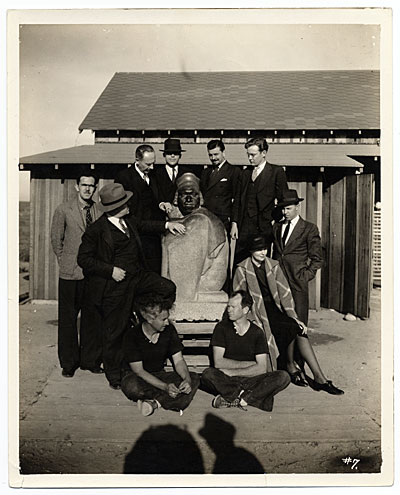The Collective Stupidity: Reverse Curve for the Arts
By Peter Walsh
“There’s a gude time coming.”
—Sir Walter Scott, Rob Roy (1817)
Americans, always attuned to the prices and classes of commodity, assume that the arts fall into the expensive luxury category: an ornament to good times but destined to wilt, like a hot house orchid, under the cold wind of recession. History suggests otherwise.

Federal Art Project artists: The Great Depression created opportunities for them.
In fact, in America, the arts may counter downward economic cycles as effectively Wal-Mart.
Consider the Great Depression. Stock markets fell, but George Balanchine, the School of American Ballet, and American Ballet Theatre all arrived on the American cultural landscape. Modern dancers like Martha Graham built towering reputations while others, like Merce Cunningham, got their start. The Boston Symphony, under Serge Koussevitsky, reached one of its greatest peaks, commissioning new works by Maurice Ravel, George Gershwin, and Igor Stravinsky.
The New Yorker, founded in 1925, not only survived bad times but became widely renowned for its elegant writing, lively wit, cartoons, and reviews. The Museum of Modern Art, opened nine days after the 1929 crash, organized path-breaking exhibitions, assembled a legendary curatorial staff, collected great works, and built a landmark modernist building in Manhattan. The Group Theatre nurtured some of the greatest talents in American acting, directing, and playwriting, including Clifford Odets, Stella Adler, and Lee Strasberg.
Frank Lloyd Wright, his career and finances in the doldrums for most of the 1920s, established the Taliesin Fellowship and created some of his greatest works, including the 1936 masterpiece Falling Water. A long list of luminous names— Jackson Pollock, David Smith, Philip Johnson, Ezra Pound, Dorothy Parker, Ansel Adams, Georgia O’Keeffe— either established their careers or flourished in the thirties.
How could this be? The simple economics are perhaps not so hard to explain.
Without the aristocratic patronage or reliable government support they get in other nations, artists in America tend to struggle, even in the best of times— often especially in the best of times. A hearty resistance to poverty is ingrained here, even during the roaring twenties.
When the bad times came, stockbrokers were ruined. But artists were really no worse off than before. For some, fortunes turned upwards.
The most essential ingredient for a thriving art community can be summed up in two words: cheap space. All art is space-greedy: it needs room for studios, rehearsal space, galleries, and performances, as well as for living. Thus real estate booms and redevelopment are often artists’ worst enemies, decline and decay are their best friends.
In New York City, during the Great Depression, rents fell so far that, thanks to rent control, thousands of Manhattan apartments went for less in the mid-1960s than they had in the late ‘20s.
In the Depression-era landscape of falling incomes, foreclosures, and tax seizures, artists found space begging for tenants. When the Shriners fell behind on the property taxes for their neo-Moorish Mecca Temple on West 55th Street, the city took it over. During World War II, the vacant building was recycled as a home for new performing groups like the New York City Ballet and the New York City Opera.
Prior to the 1930s, government support for the arts in the United States had always been notoriously stingy compared to the system of state commissions, prizes, exhibitions, academies, and government pensions common in Europe. Asked to vote support for American art, one U.S. congressman notoriously commented “Why? We can import all we want from France.”
The Roosevelt Administration’s arts programs, including the Federal Arts Project, part of the Works Progress Administration, other Depression Era government commissions, and related programs for writers, crafts, and theatre, were small potatoes in the big basket of the New Deal. But they provided starving artists like Jackson Pollock a reasonably steady paycheck to work on art full time.
For many, the income from these modest government programs represented a huge improvement both in living standards and ability to focus on their artistic careers. In the late ‘40s and ‘50s, these same artists were at the center of the post-war art boom, that made New York the hub of world art.
Will an extended recession in the U.S. kindle a similar boom today? It’s difficult to say.
Things are very different now. American artists are no longer quite so used to enduring long years of deprivation in search of some distant, possibly posthumous, fame. And the Depression Era bohemian lifestyles— a odd mixture of frugality, mutual support, and creative making do topped over with rich living— are a far cry from the gadget-crazed, luxury saturated norm of today.
In the 1930s and ‘40s, sculptor David Smith and his first wife, Dorothy Dehner, lived and worked much of the time in a run-down farm they owned near the former millionaire playground of Lake George, in upstate New York. The place had no electricity, telephone, or running water. Even the hand pump didn’t work— water for cooking, drinking, and washing had to be hauled up, pail by pail, from an old well.
Yet the Smiths enjoyed gourmet food, fine wine, and expensive art magazines, imported from France. “Oh Dorothy,” exclaimed Dehner’s aunt on a visit. “You have all of the luxuries and none of the necessities!”
The same thing could have been said about Depression artists all over America, from the wilds of Vermont and Cape Cod, to Taos and the shores of Big Sur. Wherever they could find a toe-hold in an overlooked paradise, American artists made a stand.
They may have grown softer since. The American art world is a vastly larger, richer place than it was in the 1930s. Like CitiGroup and Lehman Brothers, it may have grown foolish as well as prosperous and lost its survival skills.
Yet, if nothing else, those great artists of the Great Depression have left behind a great example, a sterling model for how to live in difficult times.
